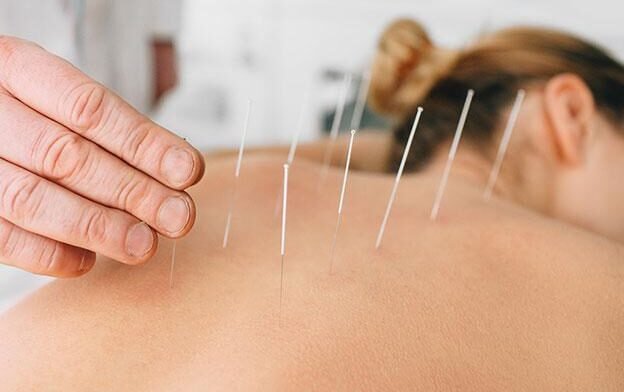WHAT IS DRY NEEDLING?

Dry needling is a technique used by physiotherapist/chiropractor that involves inserting a thin needle into a muscle or trigger point, which is a tight band of muscle that is often associated with pain or discomfort.
Unlike acupuncture, which is based on traditional Chinese medicine and involves the insertion of needles into specific meridian points, dry needling used by physiotherapist, is based on modern Western anatomy and physiology which a physiotherapist/chiropractor will perform.
The goal of dry needling is to release tight muscles and improve range of motion by stimulating a local twitch response in the affected muscle fibers.
This twitch response is thought to help break up adhesions or knots in the muscle tissue, which can lead to pain and dysfunction.
Dry needling is often used to treat a variety of musculoskeletal conditions by physiotherapist/chiropractor, including neck pain, back pain, shoulder pain, and knee pain. It may also be helpful in treating headaches, fibromyalgia, and other chronic pain conditions.
Dry needling may help relieve pain and increase your range of motion.
Conditions that dry needling may treat include:
- Joint issues.
- Disc issues.
- Tendinitis.
- Migraine and Tension type Headache.
- Jaw and mouth problems, such as Temporo mandibular (TMJ) Disorders
- Whiplash.
- Repetitive motion disorders, such as Carpal Tunnel Syndrome
- Spinal issues
- Pelvic pain
- Night cramps.
WHO CAN PERFORM DRY NEEDLING?
Only licensed healthcare professionals such as physical therapists, chiropractors, or acupuncturists who have undergone specific training in dry needling are allowed to perform the procedure.
IS DRYNEEDLING PAINFUL?
Physiotherapist are very careful in performing dry needling, it may cause some discomfort or pain, but it should not be overly painful. The needles used in dry needling are very thin and are typically inserted to a depth of just a few millimeters. When the needle is inserted into a trigger point or tight muscle, you may feel a slight twitch or ache, which is a sign that the needle has reached the affected area.
Some people describe the sensation of dry needling as a dull ache or pressure, while others may feel a sharper sensation. However, any pain or discomfort should be brief and should subside shortly after the needle is removed by the physiotherapist.
It is normal to feel a bit sore or achy in the treated area for a day or two after the procedure. However, this discomfort should not be severe and can typically be managed with ice, rest, and over-the-counter pain medication if necessary.
If you are concerned about the potential pain or discomfort associated with dry needling, it is important to discuss your concerns with KURE CLINIC, Noida/Vaishali we can provide more information and help you determine whether this treatment is appropriate for you.
.
When you can get dry needling?
Dry needling is commonly used to treat a variety of musculoskeletal conditions by physiotherapist/chiropractor, including:
- Trigger points: Dry needling by physiotherapist is often used to treat trigger points, which are small areas of tight, knotted muscle that can cause pain and discomfort.
- Muscle spasms: Dry needling by physiotherapist may be helpful in reducing muscle spasms, which can occur as a result of injury or overuse.
- Chronic pain: Dry needling by physiotherapist may be beneficial in treating chronic pain conditions such as back pain, neck pain, and headaches.
- Sports injuries: Dry needling by physiotherapist may be used as part of a comprehensive treatment plan for sports injuries, including strains, sprains, and tendonitis.
- Fibromyalgia: Dry needling by physiotherapist may be helpful in reducing pain and improving mobility in people with fibromyalgia.
It is important to note that dry needling is not appropriate for everyone, and it should not be used as a standalone treatment for any condition. A qualified physiotherapist/chiropractor will be able to assess whether dry needling is appropriate for your specific condition and can help you determine whether it should be used as part of a comprehensive treatment plan.
HOW DOES DRY NEEDLING WORK?
Dry needling is a technique that involves the insertion of thin, solid needles into the skin and underlying tissues to treat pain and other musculoskeletal conditions. The needles used in dry needling are similar to those used in acupuncture, but the two techniques differ in their underlying principles and treatment goals.
The exact mechanisms by which dry needling works are not fully understood, but it is thought to involve several physiological processes, including:
- Trigger point release: Dry needling is often used to target trigger points, which are areas of tight, knotted muscle that can cause pain and discomfort. The insertion of the needle into the trigger point can help to release tension and improve blood flow to the affected area.
- Neurological effects: The insertion of the needle into the skin and underlying tissues can stimulate nerve fibers and sensory receptors, which can help to reduce pain and improve mobility.
- Local inflammation: Dry needling can cause a small amount of local inflammation, which can help to stimulate the body’s natural healing processes and promote tissue repair.
- Endorphin release: The insertion of the needle can stimulate the release of endorphins, which are natural pain-relieving substances produced by the body.
Overall, dry needling is process to work by reducing muscle tension, improving blood flow, and stimulating the body’s natural healing processes. It is often used as part of a comprehensive treatment plan physiotherapist/chiropractor that may also include exercise, manual therapy, and other interventions aimed at reducing pain and improving function.
What are the potential side effects of dry needling?
The most common side effect of dry needling by physiotherapist is soreness during and after treatment.
Other side effects are typically minor. They may include:
- Stiffness.
- Bruising at or near the insertion site.
- Fainting.
- Fatigue.
Contact at KURE CLINIC today to arrange a session with a senior physiotherapist to discuss a targeted treatment plan.
